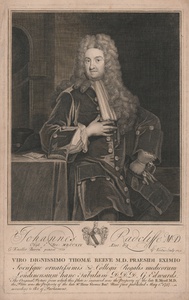| Method | Copper engraving |
| Artist | George Vertue after Sir Godfrey Kneller |
| Published | G. Kneller Baront. pinxit 1710. G. Vertue Sculp. 1719 [1757] |
| Dimensions | Image 365 x 265 mm, Plate 370 x 275 mm, Sheet 465 x 290 mm |
| Notes |
An unusual 1757 restrike of Vertue's engraved portrait of the celebrated physician and Oxford donor John Radcliffe, issued by George Edwards for the Royal College of Physicians. The portrait, after the oil painting by Sir Godfrey Kneller, shows Radcliffe three-quarter length, seated to the right with his right arm resting on a sidetable, upon which sits a hat with folded brim and a letter bearing his name. He wears a long wig, surcoat, and cravat, and his left hand is gloved, holding his other glove to the handle of his sword. The inscription space features the Arms of Radcliffe at centre, above an inscription reading: 'Obiit 1. Nov. MDCCXIV Aetat 65.' This particular issue of Vertue's engraving features a secondary inscription plate appended below, which reads: 'Viro Dignissimo Thomae Reeve M.D. Praesidi Eximio Sociisque ornatissimis &c. Collegii Regalis medicorum Londinensium hanc Tabulam D.D.D. G. Edwards. The Original Picture from which this Plate is ingraved was the Property of the late R. Mead M.D. the Plate was the Property of the late Sr. Hans Sloane Bart. Now first published May 1st 1757 according to Act of Parliament.' The inscription gives the restrike an impressive pedigree, associating it with the leading figures of the English medical world in the mid eighteenth century. The painting itself was presumably undertaken by Kneller for John Radcliffe himself, though its passing into Mead's ownership is unsurprising, as after Radcliffe's death, Richard Mead was recognised as London's preeminent physician. According to the inscription, the engraved plate was in the collection of Sir Hans Sloane, himself a member of the College and patron of George Edwards, whom the former had recommended to the College for the role of Beadle, a position Edwards applied himself to with relish, at the same time also arranging for himself to be considered the College's librarian. Thomas Reeve, to whom the restruck plate is dedicated, was at the time of printing the President of the Royal College of Physicians. George Vertue (1684-1756) was an antiquary and engraver. He was born in the parish of St. Martin-in-the-Fields, London. Vertue was apprenticed to a silver engraver and later to the Flemish engraver Michael Vandergucht. His early work includes plates after Kneller, whose academy he attended from 1711. Vertue had a deep interest in antiquarian research, and much of his work was devoted to this subject. He also served as the official engraver to the Society of Antiquaries (1717-56). From 1713 onwards, Vertue dedicated his research to the details of the history of British art, which resulted in an extensive collection of notebooks now in the British Library. The contents of which were the basis of Horace Walpole's 1762 'Anecdotes of Painting'. There are approximately five hundred portraits attributed to Vertue, and an equivalent number of published plates which were devoted to antiquarian subjects. Sir Godfrey Kneller, 1st Baronet (1646-1723) was the leading portrait painter in England during the late 17th and early 18th centuries, and was court painter to British monarchs from Charles II to George I. His major works include The Chinese Convert (1687) a series of four portraits of Isaac Newton painted at various junctures of the latter's life, a series of ten reigning European monarchs, including King Louis XIV of France, over 40 "Kit-cat portraits" of members of the Kit-Cat Club and ten "beauties" of the court of William III, to match a similar series of ten beauties of the court of Charles II painted by his predecessor as court painter, Sir Peter Lely. George Edwards (1694-1773) was, like Catesby, one of the pioneers of natural history documentation, and is known as the "Father of British Ornithology." His marvellous A Natural History of Birds (London: 1743-51) was produced almost single-handedly. Edwards not only wrote the text for the book but also made the drawings, etched the plates, and hand coloured the prints to be bound in each volume. Edwards was born at Stratford, Essex. In his early years he travelled extensively through mainland Europe, studying natural history, and gained some reputation for his coloured drawings of animals, especially birds. In 1733, on the recommendation of Sir Hans Sloane, he was appointed librarian to the Royal College of Physicians in London. O'Donohue 1 (unrecorded variant) Condition: Minor creasing to corners of sheet. |
| Framing | unmounted |
| Price | £325.00 |
| Stock ID | 52271 |

